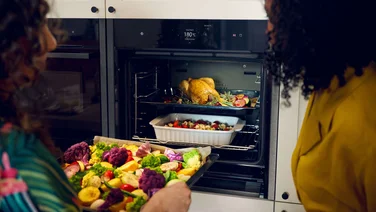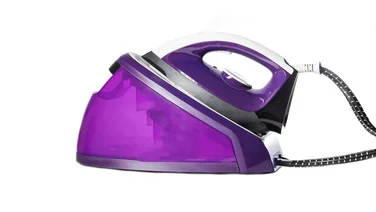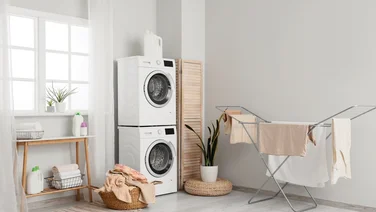To help us provide you with free impartial advice, we may earn a commission if you buy through links on our site. Learn more

Defrosting your freezer might seem like the most mundane chore ever, but it’s crucial for maintaining appliance health and efficiency. “It’s important because ice buildup reduces the available storage space and can prevent the door from sealing properly,” explains Sarah Heaps, Refrigeration Expert at AO. Sarah points out that thick frost layers also force the freezer to “work harder, increasing energy consumption and running costs.” Essentially, a frosty freezer is a money guzzler.
Heidi Phillips, Cleaning and Organisation Expert, adds, “If it is kept ice-free then it puts less pressure on the motor to work, which in turn costs less to run.” It’s not just about the bills, though: “You also reduce the lifespan of the freezer if it is very icy,” she warns. A frosty freezer can also compromise food safety. “If the freezer is very iced up then the doors may not close properly and this will allow warm air in and your food may not be properly frozen,” says Heidi.
With money, health and kitchen efficiency on the line, it’s safe to say that this is not a task to put on the long finger. So, let’s get to it with our handy guide below.
How to defrost a freezer
So, how do you defrost a freezer correctly? Before you start doing anything, it’s essential to remove all food from your freezer. Depending on how much of a defrost your freezer needs, the process could take up to 24 hours, so make sure you don’t have any food that might spoil. In a pinch, Heidi suggests that you could put food into freezer bags to keep it cold.
Once you’ve stored or jettisoned the items in your freezer, it’s time to turn it off. For the next step, you’ll need towels and a bowl that can fit into the freezer drawers or shelves easily.
“Prop the door open and place a towel on the floor,” advises Sarah. “Put a bowl of hot water on the bottom shelf and leave it there for a couple of hours. Once all the ice has melted, wipe down the interiors with a sponge.”
The above method can take quite a while; Heidi offers an alternative way to defrost a freezer, which should speed things up: “Use a hand-held steamer to blast the ice away, starting at the top and working your way down,” she says. “Use a plastic spatula to help ease off bigger chunks of ice as they loosen. Make sure to do this carefully though, as you don’t want to cause damage.”
What are some defrosting don’ts?
While we all want to get the job done faster, some defrosting “hacks” are downright dangerous. “Never, ever use a hairdryer to defrost a freezer,” Heidi says, “as you could very easily be electrocuted.” Sarah echoes this sentiment and also warns against using “knives or metal scrapers, as these can damage your freezer’s lining or cooling system.” She also advises against “pouring boiling water directly onto the ice, as sudden temperature changes can crack the plastic interior.”
Furthermore, if you need to give your freezer a helping hand with an extra clean, stay away from abrasive cleaners or scouring pads, as these can scratch or damage the lining. We recommend you stick to a soft cloth and mild cleaning solutions instead.
How to clean your freezer after defrosting
Once the ice has melted away, a thorough cleaning is essential. “Cleaning your freezer after defrosting is recommended,” Sarah says. “Remove the shelves and drawers, soak them in hot, soapy water, then gently scrub with a soft sponge.” For tough stains, an antibacterial spray should do the job, though Heidi recommends sticking to something mild – with bleach being an absolute no-go. Not only can the odour of bleach linger and affect your food, it can also damage the interior of your freezer.
For a final finishing touch, Sarah recommends cleaning the door seals with soapy water and a cloth or toothbrush.
With all that done, it’s time to turn your freezer back on. “Turn the plug back on, then put the shelves and drawers back before letting it power up and cool down again,” she says.
Preventing frost build-up
To minimise the need for future defrosting, Sarah suggests regularly checking the door seals, as faulty seals can allow warm air to enter, which causes the frost to build up. “Additionally, don’t overfill your freezer, as good air circulation helps maintain an even temperature and prevents frost from forming,” she says.
However, you’ll know the time to defrost has come again when any of the following conditions are met:
- Ice buildup exceeds ¼ inch (approximately 6mm): This thickness significantly impacts efficiency
- You’re about to do a deep clean: Defrosting provides the perfect opportunity to thoroughly clean the interior
- If you notice reduced freezer efficiency: If you observe your freezer working harder or food not freezing properly, it’s likely time to defrost
- If you haven’t defrosted in the last six months: A roughly biannual defrosting is best for ensuring optimal performance
And even if your freezer is a ‘frost free’ model, it may still require maintenance. “A frost-free fridge freezer uses a fan at the back to stop icy build-ups in your freezer compartment,” Sarah explains. “However, routine checks and cleaning are still recommended to ensure things are running smoothly.”






